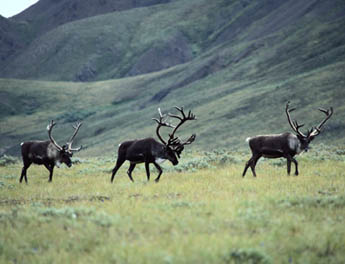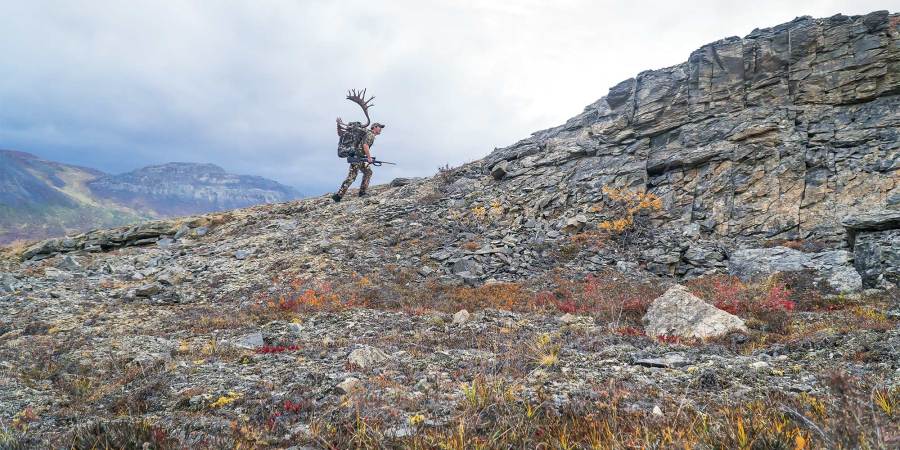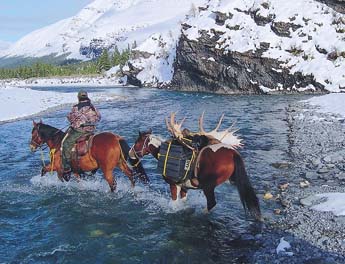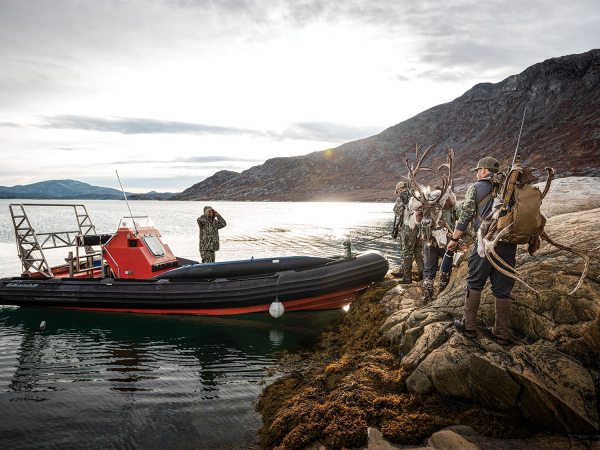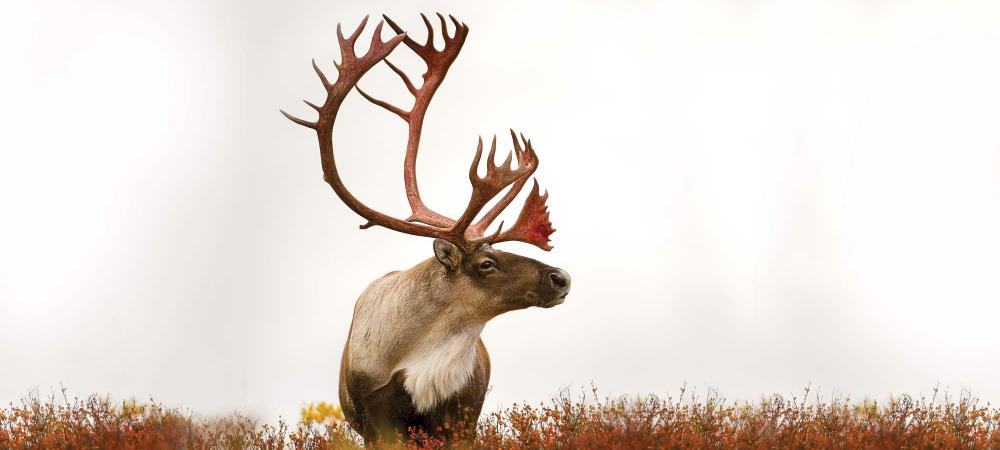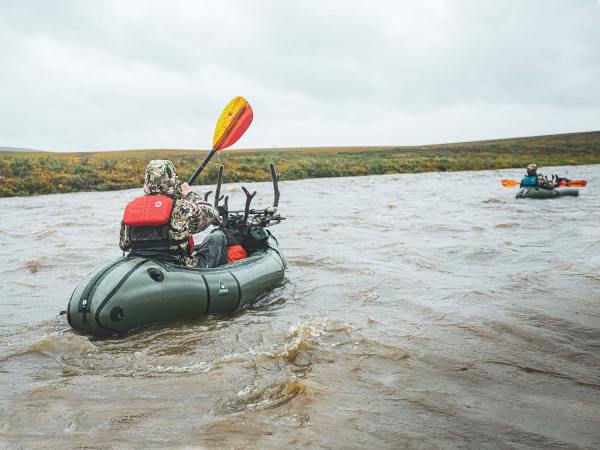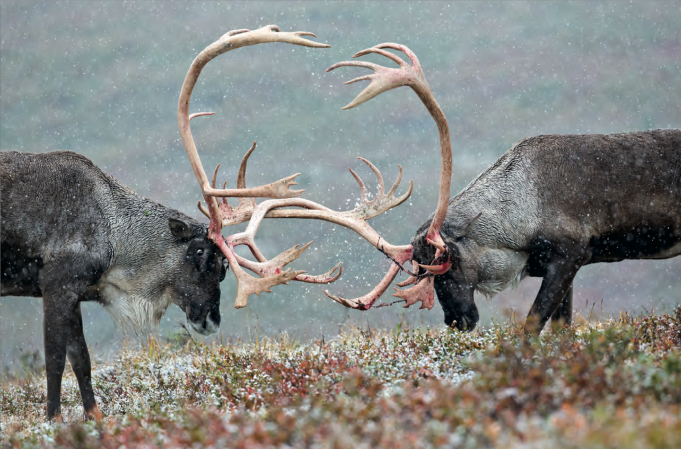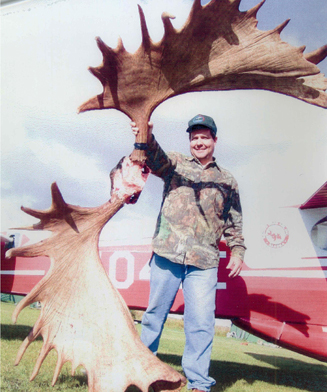We stood high on a knife-edge ridge, far above timberline and almost astride the British Columbia-Alberta border. The icy wind of the north country tore at our faces and sought the crevices in our stout woolen clothes. Just below us a marmot that had survived the excavating activities of the grizzly bear who had torn his whole village up whistled at us indignantly, and a flock of ptarmigan-conspicuously patterned with white and brown against the green of the lichens-squawked and cackled as only ptarmigan can. Far across the basin over which we had just come, land as weird and empty as the face of the moon, a lone Rocky Mountain goat was slowly going from someplace to someplace else, in the calm, deliberate manner of billy goats.
Below us the ridge fell away sharply-bare slide rock, then patches of moss and lichens and finally great timbered shoulders that swept down into the purple fir forests where a little stream meandered like a silver thread. Beyond, the country rose again into more high country like that on which we stood-big, rough ranges, spotted with the white irregular masses of glaciers and topped with jagged peaks.
“See that mountain over there with that big, flat-topped affair that looks like a coffin?” Roy Hargreaves, my outfitter, asked. “Well, we call that Coffin Top, and it is the doggondest game country you ever saw!” “Better than this?” I asked incredulously, thinking of the astonishing numbers and variety of game we had seen out of camp-bighorns, goats, caribou, deer, moose and grizzlies.
“Well,” Roy considered, “maybe not better, but as good. You’ll see everything except sheep. And caribou? You think you’ve already seen caribou. You haven’t-not compared with what’s in the Coffin Top country, anyway-Look! I see some caribou now!”
He was right. Far away, tiny specks against the white expanse of a glacier, was a herd of 50 or more caribou.
The next afternoon, after a long day with the packtrain, we pitched camp by Forgetmenot Creek, a little willow-choked stream that wandered through a wide valley that lay at the foot of Coffin Top. As soon as the tents were up, Jack Holliday, my companion, and I began looking the mountain over with the glasses. The lower slopes were thickly timbered with big fir and spruce trees, but higher up, the big trees gave way to the dwarfed alpine fir the mountain men call shin-tangle, because right at timberline it grows in a dense mass. Still higher was nothing but moss and lichens on gray slide rock, and on the very top of the mountain was the big gray “coffin,” with its flat top and perpendicular sides-a mesa, in the language of the Southwest.
As we watched, two big buck mule deer walked out of a patch of shin- tangle and began to feed in the clearing. Below them was a big bull caribou with a dark body and snow-white neck.
“Wow!” Jack shouted. “Get a load of that big buck. I want him!”
“We’ll go out there in the morning,” Roy said as he joined us, “and maybe we’ll kick that boy out. He’s got a nice head, hasn’t he?”
[pagebreak] So it came to pass that early the next morning, when the upper slopes of Coffin Top were first bathed in the clear direct rays of the rising sun, Roy, Jack, Isaac the guide and I were pushing our puffing horses through the last patches of shin-tangle toward the mountaintop.
I happened to be looking at the right time, and I was the only one who saw the buck. He jumped out of his bed and dived into the trees. Jack piled off, hoping to see him as he came out below, but it was not to be. So we put the buck in our list of things to be attended to later.
On two sides, Coffin Top dropped 2,000 feet or more in sheer cliffs of solid rock. On the side toward camp, it sloped down at an angle of about 45 degrees, and to the south, it was connected to another mountain by a long, narrow saddle. By the time we got up the slope to the compatively level top, the sun was well up, the sky was bright blue and the day was warm-or rather, it was warm enough so that, with a suit of long underwear, a pair of wool pants, a wool shirt, a sweater and a leather windbreaker, I wasn’t a bit chilly. Jack seemed to be doing right well in a few layers of wool topped by an eiderdown jacket.
We worked around the north side of the mountain, topped a little rise and saw seven bull caribou bedded down on a small glacier. We had the wind on them, and even though they were only about 600 yards away, they paid no attention to us. Jack decided to take the largest one, so, leaving my rifle behind and taking on a load of cameras, I set out behind him for the stalk. We dropped into a ravine to stay out of sight and emerged less than 200 yards from the herd.
The actual execution was done with a .22 Varminter equipped with a 440 Weaver scope-the same rifle with which Jack had killed a grizzly a few days before. His one shot hit the caribou in the neck and severed a large artery. The bull ran about 200 yards and fell, leaving a wide trail of blood behind him. Roy came up then, and while he was skinning out the head and taking a load of meat, I went over to see where the mountain dropped off to the west to see what I could see.
[pagebreak] Across the saddle, on the next mountain, another herd of caribou was taking its noonday siesta on a glacier, and in the big basin to the north, I made out single animals here and there. In the valley half a mile below, a grizzly stalked across an opening and disappeared. As I walked back to report, I saw a billy goat walking majestically right at the edge of the cliff about a quarter mile away. The one shot had disturbed him and he was changing bedrooms. We were right on the Continental Divide, and on every side giant, snow-covered peaks rose straight into the sky.
After we had eaten our sandwiches, we hunted along the cliffs and saw in all about a dozen goats. Some of them were on the British Columbia side of the mountains, and I wanted a good hide for a rug, but any one of them, if shot, would have fallen half a mile. We contented ourselves by climbing partway down the face of that incredible cliff and taking pictures of them.
Half an hour later we were on the saddle between the two mountains, sizing up the caribou with our glasses. The herd I had previously seen bedded on the big glacier was still there, and so were the bulls in the basin. One very good bull was trotting along below us, and the glasses showed he had a double shovel and heavy palmated antlers. About a dozen bulls were in sight at 600 to 1,500 yards.
Then a bull walked out of some shin-tangle and lay down on a patch of snow about 600 yards away. He was some bull, noticeably larger of body and longer of antler than any we had seen.
I handed the glasses to Isaac. “What do you think of that head?” I asked.
“Best we’ve seen on the trip,” was his quick verdict. “It’ll go fifty inches easy.”
“I’ll take him, then!” I said.
We held a council of war. Jack wanted to go over and photograph the caribou on the glacier, and I promised not to shoot until I saw him there. He and Roy set out.
When Roy and Jack had disappeared from sight over the ridge, we worked quietly downhill to a bench somewhere between 400 and 500 yards from the bull-as close as we could safely go. I put a cartridge in the chamber of my .270 in case I had to shoot quickly, and waited. We were in no hurry, since the wind was blowing our scent well past the bull, and we were above him and out of range of his indifferent vision.
After what seemed like an age, we saw Jack and Roy on the glacier sneaking up out of sight of the herd. They would soon be in photographic range.
The same cows that had trotted out of a timber-filled creek bottom spotted our bull and went over to pay a call on him. The mating season was about to begin, and from the looks of things, the cows were more enthusiastic about the prospect than the bull, who was an old fellow and doubtless had been a few places. He got to his feet politely when they approached, but as they frisked around him, he regarded them with a cold and fishy eye. I could practically read his thoughts: “I’ve chased prettier dames away with rocks!” Rebuffed by the cynical bully, one of the cows began to gaze around her. She spotted Isaac and me above the mountainside and stiffened. The two other cows saw us. Trails up, heads back, they began to circle to catch our wind.[pagebreak]
“Oh, oh!” I said. “Here we go!”
The big bull’s head went up. He regarded us long and intently. Then he began trotting smoothly along, directly across our line of vision.
I had decided that the bull was somewhere between 400 and 500 yards away, and I had already planned to hold just over his back, since the .270 was sighted for 300 yards. I settled down into a good prone position and let the bull move along with his back just under the horizontal crosshairs. Swinging with him, I got the shot off with the vertical hair about a length in front of his nose.
“Right over his back!” said Isaac, who had the glasses next to him.
I used the same lead on the next shot, but held right on top of the bull’s back. He went down as if the earth had been jerked from under him. It was one of the quickest kills I have ever seen and surely the quickest on an animal the size of a big bull mountain caribou.
Later we found the 130-grain Silvertip bullet, perfectly mushroomed, under the hide on the far side of the chest cavity. That bullet, I found, gives deeper penetration on heavy game than does Win-chester’s regular pointed expanding bullet of the same weight, and kills the big stuff more quickly.
While Isaac and I were taking the whole hide off the bull for a leather jacket, Jack and Roy came riding up. They’d got those caribou pictures they were after.
The sun was sliding down behind Coffin Top when we headed for camp with the two caribou heads, the scalps and the hide on the packhorse. We thought the day’s hunt was over. It was not. We were down in the timber once more when, across a ravine somewhere around 250 yards away, we saw a four-point buck mule deer and a two-pointer.
“Want him, Jack?” I asked.
“No. I want the big guy on the mountain!”
It was the first chance I’d had to bag a far-north mule deer without disturbing game high up on the “must” list, so I quietly got off the horse, pulled the .270 out of the scabbard and sat down. The two bucks continued to stare at us. The crosshairs came to rest low behind the buck’s foreleg, and when I finished the squeeze, he leaped into the air, then dropped from sight. We found on him. The mating season was about to begin, and from the looks of things, the cows were more enthusiastic about the prospect than the bull, who was an old fellow and doubtless had been a few places. He got to his feet politely when they approached, but as they frisked around him, he regarded them with a cold and fishy eye. I could practically read his thoughts: “I’ve chased prettier dames away with rocks!” Rebuffed by the cynical bully, one of the cows began to gaze around her. She spotted Isaac and me above the mountainside and stiffened. The two other cows saw us. Trails up, heads back, they began to circle to catch our wind.[pagebreak]
“Oh, oh!” I said. “Here we go!”
The big bull’s head went up. He regarded us long and intently. Then he began trotting smoothly along, directly across our line of vision.
I had decided that the bull was somewhere between 400 and 500 yards away, and I had already planned to hold just over his back, since the .270 was sighted for 300 yards. I settled down into a good prone position and let the bull move along with his back just under the horizontal crosshairs. Swinging with him, I got the shot off with the vertical hair about a length in front of his nose.
“Right over his back!” said Isaac, who had the glasses next to him.
I used the same lead on the next shot, but held right on top of the bull’s back. He went down as if the earth had been jerked from under him. It was one of the quickest kills I have ever seen and surely the quickest on an animal the size of a big bull mountain caribou.
Later we found the 130-grain Silvertip bullet, perfectly mushroomed, under the hide on the far side of the chest cavity. That bullet, I found, gives deeper penetration on heavy game than does Win-chester’s regular pointed expanding bullet of the same weight, and kills the big stuff more quickly.
While Isaac and I were taking the whole hide off the bull for a leather jacket, Jack and Roy came riding up. They’d got those caribou pictures they were after.
The sun was sliding down behind Coffin Top when we headed for camp with the two caribou heads, the scalps and the hide on the packhorse. We thought the day’s hunt was over. It was not. We were down in the timber once more when, across a ravine somewhere around 250 yards away, we saw a four-point buck mule deer and a two-pointer.
“Want him, Jack?” I asked.
“No. I want the big guy on the mountain!”
It was the first chance I’d had to bag a far-north mule deer without disturbing game high up on the “must” list, so I quietly got off the horse, pulled the .270 out of the scabbard and sat down. The two bucks continued to stare at us. The crosshairs came to rest low behind the buck’s foreleg, and when I finished the squeeze, he leaped into the air, then dropped from sight. We found
